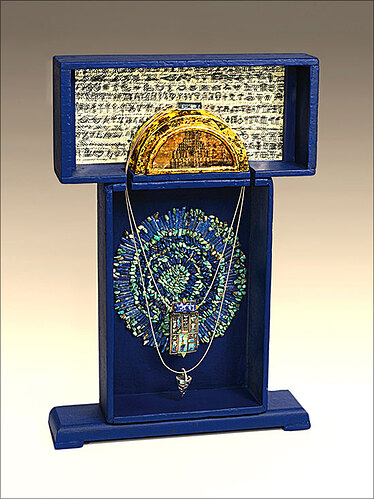Materials: Fine and Sterling Silver , 22k gold, vitreous enamel, lapis lazuli, found objects, gold leaf, plastic, turquoise, paint
Dimensions: 50.8 cm high x 35.5 cm wide x 8.3 cm deep
The Forms of the Pendants
The larger of the pendants is an extrapolation, though not quite as lofty, of the mythic breastplate of Aaron, an oracular jewel worn when evoking the divine and a symbol of that unearthly contact. The smaller, cone pendant reflects in a three-dimensional form, the cuneiform of the written language of ancient Sumeria, Akkadia, Assyria, Babylonia, and Persia. It is also a form that is used for divinatory pendulums. Both the pendulum and the breastplate are constructs for speaking/knowing truth.
The Symbols on the Pendants
The symbols on both pendants and on the clasp are drawn from Sumerian clay tablets, a Himyaritic stone carving (Yemen); Linear B (Crete) and repeated on the reverse of the large pendant, with the addition of the initials of my hallmark, my symbol.
The Gemstone
The gemstone is Lapis Lazuli. An Italian gypsy friend of mine informed me of an alternate name for this stone, “Lapis La Lingua”, which she said referred to it being the tongue of God, a stone for divination, a stone with which to speak. If translated literally, it means “language stone” or perhaps less formally as “speaking stone”.
The Nesting Case/Enclosure
The symbols on the Nesting Case reference characters from ancient languages.
Photo credit: Evans J. Soldinger
Linda Kaye-Moses
Dalton, MA. USA
My jewels concern themselves not simply with function, but also with the implicit/explicit narrative capacity of adornment, and enclosure as sculptural form. They are an extension of my intention to build fully realized objects by constructing jewels within environments or protective dwellings, “Nesting Cases”, often incorporating an original textual element (poem/song/prose). Each jewel, when not being worn, merges with a ‘nesting case’ in mutual consistency, becoming one unit.
The sources of inspiration for my work are varied: ancient artifacts; the architectural fantasies of Brodsky and Utkin; the mediaeval reliquary; the mysteries inherent in the work of William Harper, Keith LoBue and DX Ross; the complex and complicated structures that speak on many levels of human experience, especially humanity’s delight in the body-embellished.
I am invested in a continuing tradition of adornment extended to a surrounding environment, supporting and protecting the center. The ‘enclosure’, the vessel, the chest, the reliquary that contain carefully selected and assembled precious elements and that reflect intimate symbology, are both my inspiration and my art form.
My work thematically integrates jewelry fabrication techniques (metal clay, engraving, stamping, fold-forming, oxidation/patination, roll-printing, cold connections), enameling, blockprinting, assemblage/collage and precious metals, precious stones and found objects.
My pieces explore the fusion of all these elements with the stories my objects relate, each object speaking as a sculptural encyclopedia of connected and coherent images, symbols, and concepts.
These containers and vessels definitely hold their place in the world of stunning art objects as well as in the world of metalsmithing.
Since the dawn of time humans have created containers to hold things that were important to them, from large vessels to hold food and harvests to intimate containers for small precious things. They might hold memories, ashes, medicine, beverage, fruit or food - but all spring from the imagination and skill of the maker. Some have specific religious functions, some are meant for everyday use. When one thinks of a vessel or container the inclination is to think of something with solid walls - yet many of these works involve the exploration of positive and negative space, and the use of negative space to help create the illusion of the wall of the vessel.
As the world’s largest jewelry related internet site, Ganoksin strives to develop exhibitions showcasing work from around the world. This exhibition was open to all metalsmiths, professional and amateur, advanced and beginner. Participants are from The Netherlands, the USA, Canada, Australia, Costa Rica, the United Kingdom, Israel, Hong Kong, Colombia, Romania, Italy, Ireland, Japan, Malaysia and Denmark. While most of the pieces are by an individual metalsmith, some are collaborations, one of three artists spanning 50 years.
In total 319 artists contributed 729 show pieces for the permanent online exhibition.
Objects in the exhibition include boxes, lockets, urns, ash containers, bowls, wine cups, reliquaries, match holders, vases, teapots, pitchers, sugar bowls, baskets, nests, pillboxes, clutches and a range of sculptural forms. A variety of techniques are showcased covering a wide range of metalsmithing techniques. Materials used include everything from gold and silver to less expensive metals. Ornamentation includes the addition of enamel, chasing and repousse’, gemstones and found objects.
The exhibition was curated by Beth Wicker, President of the North Carolina Society of Goldsmiths in the United States, and Adjunct Instructor at Northeastern Technical College in South Carolina. Director of the exhibition is Hanuman Aspler, founder of The Ganoksin Project, the world’s largest internet jewelry site.
